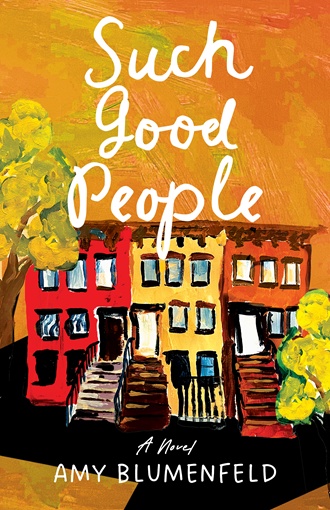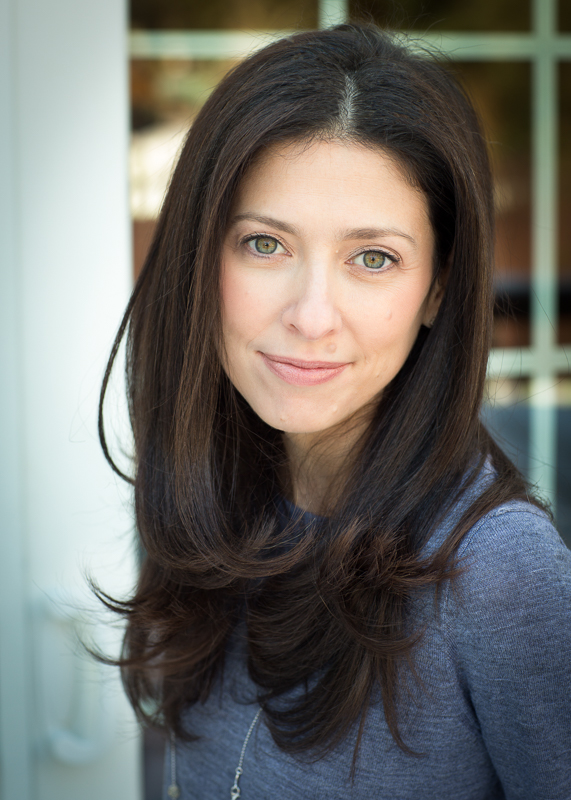My father began his career as an attorney and when I was young his colleagues would come over to our house and I’d listen to the fact patterns as they prepped their cases around our dining table. Later, when he became a judge, I’d sit beside my dad on the bench and observe arraignments from his vantage point. I learned to appreciate nuance, the complexity of situations, and understood that behind every docket number was a human being.
Amy Blumenfeld – 8 July 2025
The Back Flap
It’s 10 p.m. on a Thursday in the spring of her freshman year of college, and April is standing at the back of a crowded Manhattan bar waiting for her friend, Rudy, to arrive. Their eyes lock the moment he enters the room, and in an instant, lives and legacies are altered forever.
Within hours, Rudy is arrested. Within days, April is expelled. Within weeks, he’s incarcerated. And within months, she meets Peter, a prodigious young attorney who makes her world recognizable again.
Nearly fifteen years later, April is happily living in Chicago married to Peter, a mother of three with a fulfilling career and standing yoga date with her girlfriends. On the eve of Peter’s election for local office, Rudy is up for parole. Headlines explode about April’s past, jeopardizing Peter’s campaign and everything they hold dear. Suddenly, April is faced with an impossible choice: protecting the life she created, or the person who sacrificed everything to make that life a possibility. Such Good People is a captivating portrait of blurred lines, divided loyalties, and what it means to love purely, steadfastly, and eternally.
About the book
When did you start writing the book?
In 2019, shortly after my first book, The Cast, was published.
How long did it take you to write it?
It was an on-again, off-again project for about five years.
Where did you get the idea from?
There were a few sources of inspiration.
I was raised in a home where a painting of the scales of justice and the words “Justice, Justice, Shall You Pursue” were prominently framed on our living room wall. My father began his career as an attorney and when I was young his colleagues would come over to our house and I’d listen to the fact patterns as they prepped their cases around our dining table. Later, when he became a judge, I’d sit beside my dad on the bench and observe arraignments from his vantage point. I learned to appreciate nuance, the complexity of situations, and understood that behind every docket number was a human being. Most of the time, that human being had relatives and friends sitting on hard pews in the audience section awaiting their loved one’s case. It didn’t matter if they were on the side of the defense or prosecution. Their angst-riddled faces were directly in my line of sight and I couldn’t help but wonder about their lives. Their backstories. How being on the periphery of a criminal case impacted them.
My mother’s profession was equally formative. As an inner-city public school English teacher, she imparted her love of literature and creative writing to her students as well as to her own children. She saw beauty and potential in everyone, and like my father, encouraged critical independent thinking. She instilled in us the importance of doing our homework, of trusting but verifying, maintaining positivity and strength in the face of hardship, and always, always, having compassion for others.
After The Cast came out and I was contemplating my next book, I knew I wanted to pay tribute to these values but wasn’t sure how. Then one day I received a newsletter in the mail from a halfway house that helps formerly incarcerated individuals reenter society. A family friend was involved on the administrative end of the organization and put us on the mailing list. I started reading the newsletter and was fascinated not only by the stories of former inmates, but of the staff members – particularly the teachers – and how they found their way to working with this specific population. Reading the newsletter inspired me to create a character – a teacher who worked at a halfway house – and from there it was off to the races. I built out her backstory, created other characters, developed a plot, researched, visualized the locations and scenes, and started writing what would eventually become Such Good People.
Were there any parts of the book where you struggled?
Yes. I struggled a bit with the medical and legal portions because I really wanted to make sure I got the details right. I spoke with lawyers and doctors in different specialties to ensure I had a proper understanding of each situation from all angles. For instance, with courtroom scenes, I knew I needed to nail down the physical and verbal play-by-play from various perspectives – from the vantage point of the prosecutor, the defense attorney, the defendant, and from the family/friends sitting in the audience section. For the medical aspects of the story, the presentation of symptoms and timing of treatment had to be logical and precise while simultaneously maintaining suspense throughout the book.
What came easily?
Writing from various points of view. I thoroughly enjoy looking at the world through different characters’ eyes. It’s fun to write from each character’s vantage point and in their unique voice.
Are your characters entirely fictitious or have you borrowed from real world people you know?
My characters are entirely fictitious, but little gestures or idiosyncrasies like stacking coins in an old film canister, attaching newspaper clippings to the refrigerator with a magnet, cutting sandwiches into convenient bite sized squares for a road trip – these are inspired by observations I’ve made over time. I like to study people. One of my favorite activities is sitting on a park bench or by a window in a café and watching people stroll by.
We all know how important it is for writers to read. Are there any particular authors that have influenced how you write and, if so, how have they influenced you?
I’m inspired by many authors particularly when it comes to the architecture of a book – timeline, POV, plotting. It is interesting to see the various ways to successfully structure a novel. In terms of early influences who helped inspire a love of writing, certainly Judy Blume.
Do you have a target reader?
Anyone who enjoys a good page-turner!
About Writing
Do you have a writing process? If so can you please describe it?
Sort of! If I come up with an idea for a book, article or essay, I let it marinate in my head for a bit. If I can’t shake the concept and find myself developing and finessing it as I run errands, go for a walk, drive, etc., then I know it has potential. I’ll then sit down at the computer and get to work.
Do you outline? If so, do you do so extensively or just chapter headings and a couple of sentences?
I have a general outline. I don’t confine myself to a play-by-play sequence, but I do make a list of important plot points I need to hit in each chapter. Inevitably, the characters begin to “speak” to me and the story takes on a life of its own, so I often stray from the outline.
Do you edit as you go or wait until you’ve finished?
I edit as I go.
Do you listen to music while you write? If yes, what gets the fingers tapping?
Nope. No music. It’s funny how my process has changed over time. In college, I used to listen to music while writing papers. But now, I like a quiet space. The characters in my head make enough noise!
About Publishing
What made you decide to go Indie, whether self-publishing or with an indie publisher? Was it a particular event or a gradual process?
My first book, The Cast, was pitched to large traditional houses through my agent. Editors at two of the major traditional publishing houses expressed interest in the story, but their teams had reservations about the marketing aspect. Ultimately, those two traditional houses passed on the book. At the time, I knew a couple of writers who were having very positive experiences with Spark Press, an indie publisher led by veterans of the traditional publishing world. I decided to pitch The Cast to Spark and quickly received a warm, enthusiastic response. I had a great experience publishing The Cast with Spark, so I decided to return for my second book, Such Good People.
Did you get your book cover professionally done or did you do it yourself?
My publisher has an incredible team of professional book designers. They presented me with a few options and I selected this cover.
Any advice that you would like to give to other newbies considering becoming Indie authors?
There are a lot of great small presses out there. If you want a bit more editorial control and want to get to know your publishing team, I’d say consider it!
About You
Where did you grow up?
I was born and raised in Queens, New York and continue to live in the New York City area.
What are you working on now?
I am currently working on my third novel.
End of Interview:
Get your copy of Such Good People from Amazon US.


